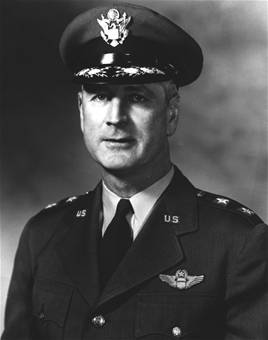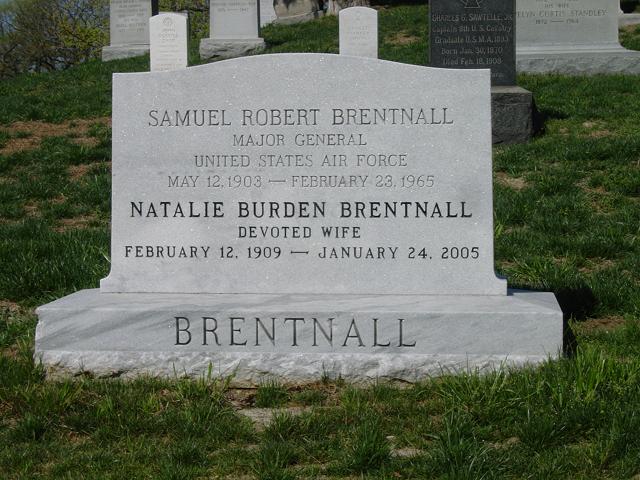Courtesy of the United States Air Force
MAJOR GENERAL SAMUEL ROBERT BRENTNALL
Retired September 30, 1956. Died February 23, 1965.
Samuel Robert Brentnall was born at Cleveland, Oklahoma, in 1903. He graduated from Phillips University in Oklahoma with a bachelor of arts degree in 1924. General Brentnall also received a doctor of philosophy from Phillips University. Entering the U.S. Military Academy that July, he graduated June 9, 1928 and was commissioned a second lieutenant of Field Artillery in the Regular Army. General Brentnall was an All-American football player at West Point from 1925 to 1928.
The following September General Brentnall entered Primary Flying School at Brooks Field, Texas and graduated from Advanced Flying School at Kelly Field, Texas in October 1929. He was then assigned to the 55th Pursuit Squadron at Rockwell Field, Calif. On Nov. 21, 1929 he transferred from the Field Artillery to the Air Corps. Assigned as a flying instructor at the Primary Flying School, March Field, California, in June 1931, the following October he transferred to Randolph Field, Texas in the same capacity.
Going to the Panama Canal Zone in February 1935, General Brentnall was assigned to the 16th Pursuit Group and later served there with the 29th and 78th pursuit squadrons. On his return to the United States in October 1936 he became Air Corps representative at the Stearman Aircraft Factory, Wichita, Kan. The following July he entered the Air Corps Engineering School at Wright Field, Ohio and graduated in August 1938. A month later he began a mechanical engineering course at Leland Stanford University in Calif., from which he graduated with a mechanical engineering-aeronautical degree.
Assigned to Wright Field, Ohio in August 1939, General Brentnall served in the Experimental Section of the Materiel Division, and later was appointed chief of the Production Engineering Section there. Transferring to Army Air Force headquarters in Washington, D.C., in August 1943, he was named chief of the Production Branch in the Materiel Division. Going overseas in May 1945 General Brentnall joined the U.S. Strategic Air Force in Europe, returning to Army Air Force headquarters in July 1946.
Reassigned to Wright Field the following month, General Brentnall served with the Engineering Division and a year later was designated assistant deputy commanding general for research & development there. In October 1947 he was named chief of the Industrial Mobilization Planning Division there, the following month became deputy director of research & development, and in October 1949 was appointed director of research & development. A year later General Brentnall was appointed special assistant to the chief of staff, U.S. Air Force, for the B-47 program, with station at Wright-Patterson Air Force Base, and the following February was designated director of Production and Service Engineering there.
Transferring to Far East Air Force on July 20, 1951, General Brentnall was named special assistant to the commanding general; that August was appointed assistant vice commander of FEAF, and a month later was designated vice commander.
Moving to Washington, D.C., on Aug. 24, 1953, General Brentnall served with the Office of the Secretary of Defense as assistant for production, Office of Guided Missiles. A month later he was designated assistant deputy chief of staff, operations, for guided missiles at Air Force headquarters, and on April 8, 1954 were named assistant chief of staff for guided missiles.
He received an honorary doctor of science degree from Phillips University, Okla., in May 1955. He was rated a command pilot.
MAJOR AWARDS AND DECORATIONS
His decorations include the Distinguished Service Medal, Legion of Merit with oak leaf cluster, and the Bronze Star.
Michael Robert Patterson was born in Arlington and is the son of a former officer of the US Army. So it was no wonder that sooner or later his interests drew him to American history and especially to American military history. Many of his articles can be found on renowned portals like the New York Times, Washingtonpost or Wikipedia.
Reviewed by: Michael Howard


